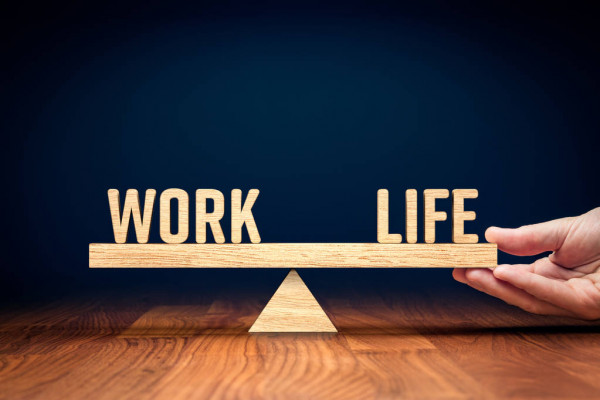
Balancing your professional and personal life can be challenging, but it’s essential. Here’s how to improve your work-life balance today.
Often, work takes precedence over everything else in our lives. Our desire to succeed professionally can push us to set aside our own well-being. Creating a harmonious work-life balance or work-life integration is critical, though, to improve not only our physical, emotional and mental well-being, but it’s also important for our career.

What is work-life balance, and why is it important?
In short, work-life balance is the state of equilibrium where a person equally prioritizes the demands of one’s career and the demands of one’s personal life. Some of the common reasons that lead to a poor work-life balance include:
- Increased responsibilities at work
- Working longer hours
- Increased responsibilities at home
- Having children
A good work-life balance, said Chris Chancey, career expert and CEO of Amplio Recruiting, has numerous positive effects, including less stress, a lower risk of burnout and a greater sense of well-being. This not only benefits employees but employers, too.
“Employers who are committed to providing environments that support work-life balance for their employees can save on costs, experience fewer cases of absenteeism, and enjoy a more loyal and productive workforce,” said Chancey. Employers that offer optionsas telecommuting or flexible work schedules can help employees have a better work-life balance.
When creating a schedule that works for you, think about the best way to achieve balance at work and in your personal life. Chancey said that work-life balance is less about dividing the hours in your day evenly between work and personal life and, instead, is more about having the flexibility to get things done in your professional life while still having time and energy to enjoy your personal life. There may be some days where you work longer hours so you have time later in the week to enjoy other activities.
Here are eight ways to create a better work-life balance, as well as how to be a supportive manager.
1. Accept that there is no ‘perfect’ work-life balance.
When you hear “work-life balance,” you probably imagine having an extremely productive day at work, and leaving early to spend the other half of the day with friends and family. While this may seem ideal, it is not always possible.
Don’t strive for the perfect schedule; strive for a realistic one. Some days, you might focus more on work, while other days you might have more time and energy to pursue your hobbies or spend time with your loved ones. Balance is achieved over time, not each day.
“It is important to remain fluid and constantly assess where you are [versus] your goals and priorities,” said Heather Monahan, founder of the career mentoring group, #BossinHeels. “At times, your children may need you, and other times, you may need to travel for work, but allowing yourself to remain open to redirecting and assessing your needs on any day is key in finding balance.”
2. Find a job that you love.
Although work is an expected societal norm, your career shouldn’t be restraining. If you hate what you do, you aren’t going to be happy, plain and simple. You don’t need to love every aspect of your job, but it needs to be exciting enough that you don’t dread getting out of bed every morning.
Monahan recommended finding a job that you are so passionate about you would do it for free. “If your job is draining you, and you are finding it difficult to do the things you love outside of work, something is wrong,” said Monahan. “You may be working in a toxic environment, for a toxic person, or doing a job that you truly don’t love. If this is the case, it is time to find a new job.”
3. Prioritize your health.
Your overall physical, emotional and mental health should be your main concern. If you struggle with anxiety or depression and think therapy would benefit you, fit those sessions into your schedule, even if you have to leave work early or ditch your evening spin class. If you are battling a chronic illness, don’t be afraid to call in sick on rough days. Overworking yourself prevents you from getting better, possibly causing you to take more days off in the future.
“Prioritizing your health first and foremost will make you a better employee and person,” said Monahan. “You will miss less work, and when you are there, you will be happier and more productive.”
Prioritizing your health doesn’t have to consist of radical or extreme activities. It can be as simple as daily meditation or exercise.
4. Don’t be afraid to unplug.
Cutting ties with the outside world from time to time allows us to recover from weekly stress, and gives us space for other thoughts and ideas to emerge. Unplugging can mean something simple like practicing https://www.businessnewsdaily.com, instead of checking work emails.
Monahan said when she used to travel with her boss for work, she’d look over to find him reading a novel while she would be doing something work-related.
“I didn’t understand at the time that he was giving himself a break and decompressing while I was leading myself to a potential burnout,” said Monahan.
Now, Monahan practices the same tactics. She reiterated that taking that time to unwind is critical to success and will help you feel more energized when you’re on the clock.
5. Take a vacation.
Sometimes, truly unplugging means taking vacation time and shutting work completely off for a while. Whether your vacation consists of a one-day staycation or a two-week trip to Bali, it’s important to take time off to physically and mentally recharge.
According to the State of American Vacation 2018 study conducted by the U.S. Travel Association, 52% of employees reported having unused vacation days left over at the end of the year. Employees are often worried that taking time off will disrupt the workflow, and they will be met with a backlog of work when they return. This fear should not restrict you from taking a much-needed break.
“The truth is, there is no nobility in not taking well-deserved time away from work; the benefits of taking a day off far outweigh the downsides,” said Chancey. “With proper planning, you can take time away without worrying about burdening your colleagues or contending with a huge workload when you return.”
6. Make time for yourself and your loved ones.
While your job is important, it shouldn’t be your entire life. You were an individual before taking this position, and you should prioritize the activities or hobbies that make you happy. Chancey said that achieving work-life balance requires deliberate action.
“If you do not firmly plan for personal time, you will never have time to do other things outside of work,” said Chancey. “No matter how hectic your schedule might be, you ultimately have control of your time and life.”
When planning time with your loved ones, create a calendar for romantic and family dates. It may seem weird to plan one-on-one time with someone you live with, but it will ensure that you spend quality time with them without work-life conflict. Just because work keeps you busy doesn’t mean you should neglect personal relationships.
“Realize that no one at your company is going to love you or appreciate you the way your loved ones do,” said Monahan. “Also [remember] that everyone is replaceable at work, and no matter how important you think your job is, the company will not miss a beat tomorrow if you are gone.”
7. Set boundaries and work hours.
Set boundaries for yourself and your colleagues, to avoid burnout. When you leave the office, avoid thinking about upcoming projects or answering company emails. Consider having a separate computer or phone for work, so you can shut it off when you clock out. If that isn’t possible, use separate browsers, emails or filters for your work and personal platforms.
Additionally, Chancey recommended setting specific work hours. “Whether you work away from home or at home, it is important to determine when you will work and when you will stop working; otherwise, you might find yourself answering work-related emails late at night, during vacations or on weekends off,” said Chancey.
Chancey advised notifying team members and your manager about boundaries beyond which you cannot be accessible, because you are engaged in personal activities. This will help to ensure that they understand and respect your workplace limits and expectations.
8. Set goals and priorities (and stick to them).
https://www.businessnewsdaily.com by implementing time-management strategies, analyzing your to-do list and cutting out tasks that have little to no value.
Pay attention to when you are most productive at work and block that time off for your most important work-related activities. Avoid checking your emails and phone every few minutes, as those are major time-wasting tasks that derail your attention and productivity. Structuring your day can increase productivity at work, which can result in more free time to relax outside of work.
The rise of the flexible workplace
Those who do maintain a successful balance between their often point to their flexible work schedules. Recent research found that in the past seven years, many employers have allowed workers greater flexibility both with their schedule and where they work.
“It is clear that employers continue to struggle with fewer resources for benefits that incur a direct cost,” said Ken Matos, lead researcher and senior director of employment research and practice at the nonprofit research organization Families and Work Institute. “However, they have made it a priority to grant employees access to a wider variety of benefits that fit their individual and family needs and that improve their health and well-being.”
Flexibility can pay off for employers in the long run. “As we look ahead, it is clear that in order to remain competitive, employers must find ways to offer flexible work options if they want to attract and retain top talent,” said Hank Jackson, president and CEO of the Society for Human Resource Management.
“Work-life balance will mean different things to different people because, after all, we all have different life commitments,” said Chancey. “In our always-on world, balance is a very personal thing, and only you can decide the lifestyle that suits you best.”
How to be a supportive manager
To help managers do a better job of supporting their employees’ efforts to achieve a healthier work-life balance, Robert Half Management Resources offers four tips
- Know what your employees are striving for.Not everyone has the same work-life balance goals. Talk to each employee about their objectives, and then determine what you can do to help them. Some employees may benefit from working remotely a couple days each week, while others may prefer altering their daily work schedule. It’s important to be open-minded and flexible.
- Set a good example.Your employees follow your lead. If you send emails at all hours of the day and night or work hard on the weekends, you staff thinks that is what is expected of them, too.
- Let employees know what their options are.
- While employers typically do a good job of highlighting their work-life balance offerings to prospective job candidates, the same can’t be said for communicating those initiatives to current employees. Regularly discuss with your employees the options that are available to them. Also, sit down with soon-to-be parents and discuss parental leave options.
- Stay at the forefront. It is important to keep ahead of the curve on emerging work-life balance trends. What works today for employees might not be a good fit a year from now. Keep your work-life balance initiatives fresh, and offer in-demand benefits. Plus, consider offering work-life programs.











